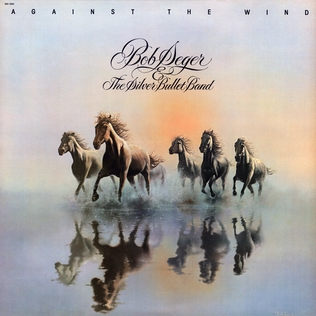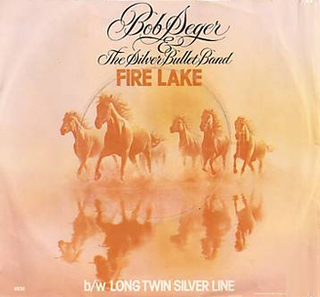
Tom Petty and the Heartbreakers were an American rock band from Gainesville, Florida. Formed in 1976, the band originally comprised lead singer and rhythm guitarist Tom Petty, lead guitarist Mike Campbell, keyboardist Benmont Tench, drummer Stan Lynch and bassist Ron Blair. In 1982, Blair, weary of the touring lifestyle, departed the band. His replacement, Howie Epstein, stayed with the band for the next two decades. In 1991, Scott Thurston joined the band as a multi-instrumentalist—mostly on rhythm guitar and second keyboard. In 1994, Steve Ferrone replaced Lynch on drums. Blair returned to the Heartbreakers in 2002, the year before Epstein's death. The band had a long string of hit singles including "Breakdown", "American Girl", "Refugee", "The Waiting", "Learning to Fly", and "Mary Jane's Last Dance", among many others, that stretched over several decades of work.

Robert Clark Seger is a retired American singer, songwriter, and musician. As a locally successful Detroit-area artist, he performed and recorded as Bob Seger and the Last Heard and the Bob Seger System throughout the 1960s, breaking through with his first album, Ramblin' Gamblin' Man in 1969. By the early 1970s, he had dropped the 'System' from his recordings and continued to strive for broader success with various other bands. In 1973, he put together the Silver Bullet Band, with a group of Detroit-area musicians, with whom he became most successful on the national level with the album Live Bullet (1976), recorded live with the Silver Bullet Band in 1975 at Cobo Hall in Detroit, Michigan. In 1976, he achieved a national breakout with the studio album Night Moves. On his studio albums, he also worked extensively with the Alabama-based Muscle Shoals Rhythm Section, which appeared on several of Seger's best-selling singles and albums.

Ramblin' Gamblin' Man is the first studio album by American rock band the Bob Seger System, released in 1969. The original title was Tales of Lucy Blue, hence the cover art. In the liner notes, Bob Seger says (sarcastically) he later realized Lucy Blue was "Ramblin' Gamblin' Man", and so changed the title of the album. He then thanks "Doctor Fine" for this realization. The original cover design for the album featured the nude figure from Botticelli's The Birth of Venus, but this too was changed for the final release.

Back in '72 is the sixth studio album by American rock singer-songwriter Bob Seger, released in 1973. It was the first new album on Seger's manager Punch Andrews' label, Palladium Records, to be released under their distribution deal with the Reprise division of Warner Bros. Records and one of three early Seger albums that has never been reissued on CD.

Seven is the seventh studio album by American rock singer-songwriter Bob Seger, released in 1974.

Beautiful Loser is the eighth studio album by American rock artist Bob Seger, released in 1975. This album marked Seger's return to Capitol Records after a four-year split. His previous record with Capitol was Brand New Morning in 1971.

Stranger in Town is the tenth studio album by American rock singer Bob Seger and his second with the Silver Bullet Band, released by Capitol Records in May 1978. As with its predecessor, the Silver Bullet Band backed Seger on about half of the songs and the Muscle Shoals Rhythm Section backed Seger on the other half.

Against the Wind is the eleventh studio album by American rock singer Bob Seger and his fourth which credits the Silver Bullet Band. Like many of his albums, about half of the tracks feature the Muscle Shoals Rhythm Section as backing musicians. It was released in February 1980. It is Seger's only number-one album to date, spending six weeks at the top of the Billboard Top LPs chart, knocking Pink Floyd's The Wall from the top spot.

The Distance is the twelfth studio album by US-American rock singer Bob Seger. It was released in the final week of 1982. It peaked at #5 on Billboard's album chart and sold close to two million copies in the United States.

Like a Rock is the thirteenth studio album by American singer-songwriter Bob Seger, released in 1986. The title track is best known for being featured in Chevrolet truck commercials throughout the 1990s and early 2000s.

The Fire Inside is the fourteenth studio album by American singer-songwriter Bob Seger. The album was released in mid 1991 on the record label, Capitol. It was Seger's first album of entirely new music since Like a Rock in 1986. Though credited to "The Silver Bullet Band", much of the album used guest and session musicians, with limited contributions from Silver Bullet Band members. Among the guest artists on the album are Joe Walsh, Bruce Hornsby, Roy Bittan, Steve Lukather, Don Was, Waddy Wachtel, Rick Vito, Mike Campbell, Patty Smyth, Lisa Germano, and Kenny Aronoff.

"Night Moves" is a song by American singer-songwriter Bob Seger. It was the lead single from his ninth studio album of the same name (1976), which was released on Capitol Records. Seger wrote the song as a coming of age tale about adolescent love and adult memory of it. It was based on Seger's own teenage love affair he experienced in the early 1960s. It took him six months to write and was recorded quickly at Nimbus Nine Studios in Toronto, Ontario, with producer Jack Richardson. As much of Seger's Silver Bullet Band had returned home by this point, the song was recorded with several local session musicians.

Greatest Hits is a compilation album by Bob Seger & the Silver Bullet Band, released in 1994. Certified Diamond by the RIAA, it is Seger's most successful album to date. In December 2009, Billboard and Nielsen SoundScan confirmed that with nearly nine million copies sold. Bob Seger's Greatest Hits was the decade's best-selling catalog album in the United States, even out-selling The Beatles' 1 and Michael Jackson's Number Ones. By September 2011, the album had sold a total of 9,062,000 copies in the United States.

Greatest Hits 2 is a compilation album by Bob Seger, released in 2003.

"Fire Lake" is a song written and recorded by the American musical artist Bob Seger. He had planned to record "Fire Lake" for his 1975 album Beautiful Loser, but the track was not finished. The song had been partly written years before, in 1971, and was finally finished in 1979 and released in 1980 on Seger's album Against the Wind. The single reached number 6 on the Billboard Hot 100. A live version of the song appeared on the album Nine Tonight, released in 1981.

"Old Time Rock and Roll" is a song written by George Jackson and Thomas E. Jones III, with uncredited lyrics by Bob Seger. It was recorded by Seger for his tenth studio album Stranger in Town. It was also released as a single in 1979. It is a sentimentalized look back at the music of the original rock 'n' roll era and has often been referenced as Seger's favorite song. The song gained renewed popularity after being featured in the 1983 film Risky Business. It has since become a standard in popular music and was ranked number two on the Amusement & Music Operators Association's survey of the Top 40 Jukebox Singles of All Time in 1996. It was also listed as one of the Songs of the Century in 2001 and ranked No. 100 in the American Film Institute's 100 Years...100 Songs poll in 2004 of the top songs in American cinema.

"Heartache Tonight" is a song written by Don Henley, Glenn Frey, Bob Seger and J. D. Souther, recorded by the Eagles and features Glenn Frey on lead vocals. The track was included on their album The Long Run and released as a single in 1979. It reached No. 1 on the U.S. Billboard Hot 100 in November of that year and was certified Platinum by the Recording Industry Association of America representing one million copies sold. It was the Eagles' final chart-topping song on the Hot 100.

"American Storm" is a song written by American singer-songwriter Bob Seger. It was recorded with The Silver Bullet Band and released in March 1986 as the lead single from their album Like a Rock. The single peaked at number 13 on the U.S. Billboard Hot 100 chart and at number 2 on the US Billboard Mainstream Rock Tracks chart.

"Radioactive" is a song by American musician and Kiss member Gene Simmons, released on September 18, 1978, by Casablanca Records. It was released as the lead single from his studio album Gene Simmons, which was also released on that same day. The song was written by Simmons and Ron Frangipane and produced by Simmons and Sean Delaney. It peaked at #47 on the US Billboard charts during an eight-week run between April and May 1979. When the single was released, a limited-edition red vinyl 45 rpm album was made available.

"Whiskey" is a song recorded by American band Maroon 5 featuring American rapper ASAP Rocky. It was released on October 20, 2017, as the second promotional single from the band's sixth studio album Red Pill Blues (2017). The song was written by Adam Levine, Rakim Mayers, John Ryan, Jacob Kasher Hindlin, and Tinashe Sibanda and was produced by John Ryan, Maxime Devaux and JKash.




















